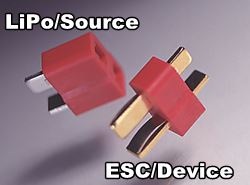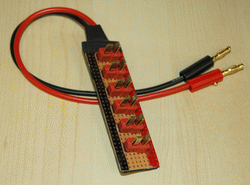Understanding The Deans Connector
by John Salt
The Deans or T Connector were one of the first LiPo connectors on the block, and remain to be a popular RC connector type with a very loyal following.
The Deans "Ultra" connectors are rated for 60 Amps of continuous load, up to 75 Amp & higher bursts. I have pushed mine to 100 Amp for short spikes without issue.
One of their best attributes is they are small in size for their current rating. If you have very tight spacing in your RC model or other application, Deans connectors may be your best choice for fitment reasons alone.
I used Deans connectors for several years when I first got into electric
powered flight and liked them; but converted over to AMASS XT60's since, and have never
looked back to be honest. You know, the old personal preference thing.
Deans
connectors use sprung flat tabs for the connector which is a departure
from most other connectors that use "bullet" style pins. This in my
experience makes the Deans one of the better plugs for consistent
connectivity pressure as the sprung tabs don't seem to lose their
contact pressure over time after many cycles like bullet connectors sometimes do.
Like
almost every RC LiPo battery connector out there, there are a good deal
of copied/clones of Deans T connectors on the market, and some I
actually like better than the original because they are textured making
them easier to plug/unplug. Some on the other hand are complete garbage!
I would say what I dislike the most with Deans/T style connectors, is I find them difficult to connect, more so than disconnecting which is quite easy. Wires are soldered onto the back side tabs which requires heat shrink to insulate but makes removal/reuse easy.
The plastic body on Deans plugs is fairly heat sensitive so you have to be careful while soldering to avoid softening the plastic which can loosens or miss-aligns the connector tabs. Some copies/clones actually have better heat immunity than the originals I have found.
Deans Connector Soldering Video
Male Deans Short Potential
There is one caution I should mention about male Deans/T connectors, and that is the shorting potential.
As seen in this image, all the male pins on this parallel charging board are exposed and have a short potential with something conductive (like a screwdriver shaft or other tool) accidentally touched to the exposed pins.
It's not a deal breaker by any stretch and most commercially available Deans parallel charging boards like this one come with insulating caps to cover the exposed pins, but it's something to be careful with whenever using a Deans parallel charging board.
- Deans T Connector Deals @ Amazon.
- Deans Parallel Charging Boards @ Amazon.
- Deans T Connectors @ Buddy RC.
- Deans Parallel Charging Board @ Buddy RC.
For more helpful RC connector information & soldering tips, please see my RC Battery Connector Page.










